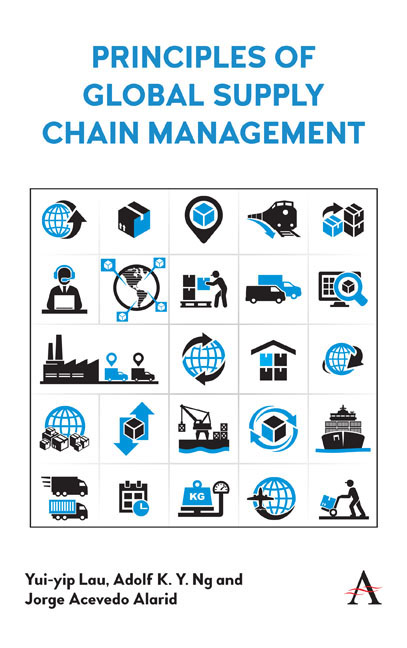Book contents
- Frontmatter
- Contents
- List of Figures
- List of Tables
- Foreword
- Preface
- About the Authors
- 1 Introduction
- 2 Managing Outbound Logistics and Distribution
- 3 Supplier Selection and Procurement
- 4 Warehouse Management
- 5 Case Studies in Food Supply Chains
- 6 Inland Ports in Global Supply Chains
- 7 Climate Change in a Global Environment
- 8 Sustainability in Infrastructure-Based Supply Chains
- 9 Reverse Logistics
- 10 Logistics Associations
- 11 Logistics Education
- 12 Case Exercises in Global Supply Chains
- Appendix
- Index
Preface
- Frontmatter
- Contents
- List of Figures
- List of Tables
- Foreword
- Preface
- About the Authors
- 1 Introduction
- 2 Managing Outbound Logistics and Distribution
- 3 Supplier Selection and Procurement
- 4 Warehouse Management
- 5 Case Studies in Food Supply Chains
- 6 Inland Ports in Global Supply Chains
- 7 Climate Change in a Global Environment
- 8 Sustainability in Infrastructure-Based Supply Chains
- 9 Reverse Logistics
- 10 Logistics Associations
- 11 Logistics Education
- 12 Case Exercises in Global Supply Chains
- Appendix
- Index
Summary
Absorb what is useful, discard what is useless and add what is specifically your own.
Knowing is not enough, we must apply. Willing is not enough, we must do.
— Bruce Lee, martial artist (1940– 73)When we were designing and planning for this book, a few quick questions came to our mind: how could we transform new knowledge into practice? How important were infrastructural issues in supply chains? Were there any key research topics that have been seriously neglected in previous books publication? Were active scholars participating in research dedicated to industrial practitioners? Indeed, these are core objectives of applied research that can contribute to academic, industry and community in an ever- changing world.
This book addresses the role of supply chain in the global economy and organizations. Although global supply chain management is critical with different stakeholders within policymakers, students, researchers, logistics associations, participators, even for governmental actors who need to make strategic decisions in sustaining economic competitiveness for their countries and citizens, the core topics are often overlooked. Understanding such deficiency, we strive to include interesting, innovative, and timely topics. The contents may be similar, but different readers may have diversified expectations. Industrial practitioners may look for insight to generate appropriate strategic decisions; students and researchers may look for new ideas to develop new research areas and secure research grants; policymakers may look for best practices that will help them to develop appropriate public policies; logistics associations may look for new knowledge to review their professional training programs that align with international academic/ professional standards. Taking three years to complete this book (from writing the proposal to its final publication), we based it on four main principles, namely, “clarity” (which makes it simple for readers to comprehend), “richness” (which identifies questions from various academic experiences and disciplines to encourage readers to find out possible unexplored research or key issues), “innovations” (which stimulates readers to reflect on changing traditional, day- to- day operations for enhancement) and “practicality” (which equips learners with the skills and knowledge to work in the real world).
This book offers fundamental knowledge with many practical cases that can fulfill the needs and expectations of different parties. Readers can get invaluable insight on the future direction of supply chain development.
- Type
- Chapter
- Information
- Principles of Global Supply Chain Management , pp. xvii - xxPublisher: Anthem PressPrint publication year: 2019

